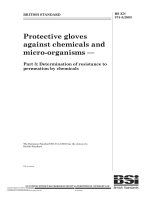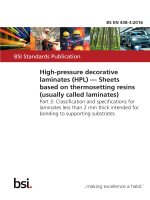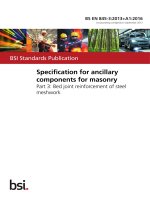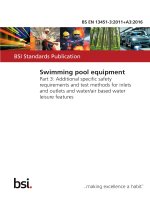Bsi bs en 61300 3 25 2016
Bạn đang xem bản rút gọn của tài liệu. Xem và tải ngay bản đầy đủ của tài liệu tại đây (2.18 MB, 16 trang )
BS EN 61300-3-25:2016
BSI Standards Publication
Fibre optic interconnecting
devices and passive
components — Basic
test and measurement
procedures
Part 3-25: Examinations and measurements —
Concentricity of non-angled ferrules and
non-angled ferrules with fibre installed
BRITISH STANDARD
BS EN 61300-3-25:2016
National foreword
This British Standard is the UK implementation of EN 61300-3-25:2016. It is
identical to IEC 61300-3-25:2016. It supersedes BS EN 61300-3-25:2013
which is withdrawn.
The UK participation in its preparation was entrusted by Technical
Committee GEL/86, Fibre optics, to Subcommittee GEL/86/2, Fibre optic
interconnecting devices and passive components.
A list of organizations represented on this committee can be obtained on
request to its secretary.
This publication does not purport to include all the necessary provisions of
a contract. Users are responsible for its correct application.
© The British Standards Institution 2016.
Published by BSI Standards Limited 2016
ISBN 978 0 580 87162 7
ICS 33.180.20
Compliance with a British Standard cannot confer immunity from
legal obligations.
This British Standard was published under the authority of the
Standards Policy and Strategy Committee on 31 December 2016.
Amendments/corrigenda issued since publication
Date
Text affected
BS EN 61300-3-25:2016
EUROPEAN STANDARD
EN 61300-3-25
NORME EUROPÉENNE
EUROPÄISCHE NORM
November 2016
ICS 33.180.20
Supersedes EN 61300-3-25:2013
English Version
Fibre optic interconnecting devices and passive components Basic test and measurement procedures Part 3-25: Examinations and measurements - Concentricity of
non-angled ferrules and non-angled ferrules with fibre installed
(IEC 61300-3-25:2016)
Dispositifs d'interconnexion et composants passifs
fibroniques - Procédures fondamentales d'essais et de
mesures - Partie 3-25: Examens et mesures - Concentricité
des férules sans angle et des férules sans angle avec fibre
montée
(IEC 61300-3-25:2016)
Lichtwellenleiter-Verbindungselemente und passive
Bauteile - Grundlegende Prüf- und Messverfahren Teil 3-25: Untersuchungen und Messungen - Konzentrizität
der nicht schräggeschliffenen Ferrulen und der nicht
schräggeschliffenen Ferrulen mit eingebauter Faser
(IEC 61300-3-25:2016)
This European Standard was approved by CENELEC on 2016-10-04. CENELEC members are bound to comply with the CEN/CENELEC
Internal Regulations which stipulate the conditions for giving this European Standard the status of a national standard without any alteration.
Up-to-date lists and bibliographical references concerning such national standards may be obtained on application to the CEN-CENELEC
Management Centre or to any CENELEC member.
This European Standard exists in three official versions (English, French, German). A version in any other language made by translation
under the responsibility of a CENELEC member into its own language and notified to the CEN-CENELEC Management Centre has the
same status as the official versions.
CENELEC members are the national electrotechnical committees of Austria, Belgium, Bulgaria, Croatia, Cyprus, the Czech Republic,
Denmark, Estonia, Finland, Former Yugoslav Republic of Macedonia, France, Germany, Greece, Hungary, Iceland, Ireland, Italy, Latvia,
Lithuania, Luxembourg, Malta, the Netherlands, Norway, Poland, Portugal, Romania, Slovakia, Slovenia, Spain, Sweden, Switzerland,
Turkey and the United Kingdom.
European Committee for Electrotechnical Standardization
Comité Européen de Normalisation Electrotechnique
Europäisches Komitee für Elektrotechnische Normung
CEN-CENELEC Management Centre: Avenue Marnix 17, B-1000 Brussels
© 2016 CENELEC All rights of exploitation in any form and by any means reserved worldwide for CENELEC Members.
Ref. No. EN 61300-3-25:2016 E
BS EN 61300-3-25:2016
EN 61300-3-25:2016
European foreword
The text of document 86B/3900/CDV, future edition 3 of IEC 61300-3-25, prepared by SC 86B “Fibre
optic interconnecting devices and passive components” of IEC/TC 86 “Fibre optics" was submitted to
the IEC-CENELEC parallel vote and approved by CENELEC as EN 61300-3-25:2016.
The following dates are fixed:
•
latest date by which the document has to be
implemented at national level by
publication of an identical national
standard or by endorsement
(dop)
2017-07-04
•
latest date by which the national
standards conflicting with the
document have to be withdrawn
(dow)
2017-10-04
This document supersedes EN 61300-3-25:2013.
Attention is drawn to the possibility that some of the elements of this document may be the subject of
patent rights. CENELEC [and/or CEN] shall not be held responsible for identifying any or all such
patent rights.
Endorsement notice
The text of the International Standard IEC 61300-3-25:2016 was approved by CENELEC as a
European Standard without any modification.
In the official version, for Bibliography, the following note has to be added for the standard indicated :
ISO 2538
1)
2
NOTE
1)
Harmonized as EN ISO 2538 .
The latest edition is superseded by EN ISO 2538-1:2014 and EN ISO 2538-2:2014.
–2–
BS EN 61300-3-25:2016
IEC 61300-3-25:2016 © IEC 2016
CONTENTS
FOREWORD ......................................................................................................................... 3
1
Scope ............................................................................................................................ 5
2
Normative references..................................................................................................... 5
3
General description ....................................................................................................... 5
3.1
General ................................................................................................................. 5
3.2
Method A: ferrule surface reference method (reference test method) ...................... 6
3.3
Method B: core centre reference method on a ferrule with fibre installed ................ 6
4
Apparatus ...................................................................................................................... 6
4.1
Method A .............................................................................................................. 6
4.2
Method B .............................................................................................................. 6
5
Procedure ..................................................................................................................... 6
5.1
Method A-1 ........................................................................................................... 6
5.2
Method A-2 ........................................................................................................... 7
5.3
Method B .............................................................................................................. 8
6
Details to be specified ................................................................................................... 9
6.1
Method A .............................................................................................................. 9
6.2
Method B .............................................................................................................. 9
Bibliography ....................................................................................................................... 10
Figure 1 – Definition of concentricity ..................................................................................... 5
Figure 2 – Set-up example for concentricity measurement (method A-1) of ferrules
with fibre installed ................................................................................................................. 7
Figure 3 – Set-up example for concentricity measurement (method A-2) of bare
ferrules ................................................................................................................................. 8
Figure 4 – Set-up example for concentricity measurement (method B) of ferrules with
fibre installed ........................................................................................................................ 9
BS EN 61300-3-25:2016
IEC 61300-3-25:2016 © IEC 2016
–3–
INTERNATIONAL ELECTROTECHNICAL COMMISSION
____________
FIBRE OPTIC INTERCONNECTING DEVICES AND PASSIVE
COMPONENTS – BASIC TEST AND MEASUREMENT PROCEDURES –
Part 3-25: Examinations and measurements – Concentricity of
non-angled ferrules and non-angled ferrules with fibre installed
FOREWORD
1) The International Electrotechnical Commission (IEC) is a worldwide organization for standardization comprising
all national electrotechnical committees (IEC National Committees). The object of IEC is to promote
international co-operation on all questions concerning standardization in the electrical and electronic fields. To
this end and in addition to other activities, IEC publishes International Standards, Technical Specifications,
Technical Reports, Publicly Available Specifications (PAS) and Guides (hereafter referred to as “IEC
Publication(s)”). Their preparation is entrusted to technical committees; any IEC National Committee interested
in the subject dealt with may participate in this preparatory work. International, governmental and nongovernmental organizations liaising with the IEC also participate in this preparation. IEC collaborates closely
with the International Organization for Standardization (ISO) in accordance with conditions determined by
agreement between the two organizations.
2) The formal decisions or agreements of IEC on technical matters express, as nearly as possible, an international
consensus of opinion on the relevant subjects since each technical committee has representation from all
interested IEC National Committees.
3) IEC Publications have the form of recommendations for international use and are accepted by IEC National
Committees in that sense. While all reasonable efforts are made to ensure that the technical content of IEC
Publications is accurate, IEC cannot be held responsible for the way in which they are used or for any
misinterpretation by any end user.
4) In order to promote international uniformity, IEC National Committees undertake to apply IEC Publications
transparently to the maximum extent possible in their national and regional publications. Any divergence
between any IEC Publication and the corresponding national or regional publication shall be clearly indicated in
the latter.
5) IEC itself does not provide any attestation of conformity. Independent certification bodies provide conformity
assessment services and, in some areas, access to IEC marks of conformity. IEC is not responsible for any
services carried out by independent certification bodies.
6) All users should ensure that they have the latest edition of this publication.
7) No liability shall attach to IEC or its directors, employees, servants or agents including individual experts and
members of its technical committees and IEC National Committees for any personal injury, property damage or
other damage of any nature whatsoever, whether direct or indirect, or for costs (including legal fees) and
expenses arising out of the publication, use of, or reliance upon, this IEC Publication or any other IEC
Publications.
8) Attention is drawn to the Normative references cited in this publication. Use of the referenced publications is
indispensable for the correct application of this publication.
9) Attention is drawn to the possibility that some of the elements of this IEC Publication may be the subject of
patent rights. IEC shall not be held responsible for identifying any or all such patent rights.
International Standard IEC 61300-3-25 has been prepared by subcommittee 86B: Fibre optic
interconnecting devices and passive components, of IEC technical committee 86: Fibre optics.
This third edition cancels and replaces the second edition published in 2013 and constitutes a
technical revision.
This edition includes the following significant technical changes with respect to the previous
edition:
a) deletion of method C due to potential damage of ferrule end face by the spindle. Method C
is the ferrule bore reference method for bare ferrules according to IEC 61300-3-25:2013;
b) separation of original method A into method A-1 and method A-2 relating to the two
different types of ferrule (with/without fibre fitted);
c) integration of the content of Annexes A and B into the test procedure.
–4–
BS EN 61300-3-25:2016
IEC 61300-3-25:2016 © IEC 2016
The text of this standard is based on the following documents:
CDV
Report on voting
86B/3900/CDV
86B/3956A/RVC
Full information on the voting for the approval of this document can be found in the report on
voting indicated in the above table.
This document has been drafted in accordance with the ISO/IEC Directives, Part 2.
A list of all parts in the IEC 61300 series, published under the general title, Fibre optic
interconnecting devices and passive components – Basic test and measurement procedures,
can be found on the IEC website.
The committee has decided that the contents of this document will remain unchanged until the
stability date indicated on the IEC website under "" in the data related to
the specific document. At this date, the document will be
•
reconfirmed,
•
withdrawn,
•
replaced by a revised edition, or
•
amended.
BS EN 61300-3-25:2016
IEC 61300-3-25:2016 © IEC 2016
–5–
FIBRE OPTIC INTERCONNECTING DEVICES AND PASSIVE
COMPONENTS – BASIC TEST AND MEASUREMENT PROCEDURES –
Part 3-25: Examinations and measurements – Concentricity of
non-angled ferrules and non-angled ferrules with fibre installed
1
Scope
This part of IEC 61300 describes the procedure to determine the concentricity of the axis of
the bore in a non-angled ferrule with the axis of the ferrule, and in the case of non-angled
ferrules with fibre installed, to determine the concentricity of the axis of the fibre core with the
axis of the ferrule.
2
Normative references
The following documents are referred to in the text in such a way that some or all of their
content constitutes requirements of this document. For dated references, only the edition
cited applies. For undated references, the latest edition of the referenced document (including
any amendments) applies.
There are no normative references in this document.
3
3.1
General description
General
This procedure describes the measurement of concentricity of ferrules and ferrules with
assembled fibres. Concentricity is defined as twice the distance between the axis of the
ferrule and the axis of the inner diameter of the ferrule (ferrule bore), or in the case of ferrules
with fibre installed, twice the distance between the axis of the ferrule and the axis of the core
of the installed fibre (see Figure 1). When concentricity measurements are made on a ferrule
with fibre installed the results will be affected by the geometry of the fibre, and by the fit of the
fibre in the ferrule inner diameter. Imperfections of the cylindricity and circularity of the
outside diameter of the ferrule will influence the measurement results.
Axis of ferrule
Axis of fibre core or ferrule bore
Concentricity
C
Fibre core
or ferrule bore
Ferrule
IEC
Figure 1 – Definition of concentricity
Two methods of concentricity measurement are described in 3.2 and 3.3.
BS EN 61300-3-25:2016
IEC 61300-3-25:2016 © IEC 2016
–6–
3.2
Method A: ferrule surface reference method (reference test method)
In Method A, the ferrule is placed in a V-groove or outer diameter (OD) reference mechanism,
and rotated. The displacement of the ferrule inner diameter or fibre core is observed and the
concentricity determined.
3.3
Method B: core centre reference method on a ferrule with fibre installed
Method B uses a roundness measuring instrument to measure concentricity. In this method,
the core axis is fixed at the axis of the measuring instrument, and the concentricity is
determined by measuring, usually with a probe, the displacement of the outer diameter of the
ferrule as the ferrule is rotated.
4
4.1
Apparatus
Method A
The apparatus for method A consists of the following elements:
•
V-groove or OD reference mechanism mounted on a micro-manipulator. According to
ISO 2538, the preferred angle for a V-groove is 108°;
•
microscope with video camera;
•
display;
•
light source; a white light is suitable for this procedure;
•
signal processor.
4.2
Method B
The apparatus for method B consists of the following elements:
•
roundness measuring instrument with microscope including a recorder, X-Y table, chuck
and pickup;
•
light source; a white light is suitable for this procedure.
5
Procedure
5.1
Method A-1
The procedure for a ferrule with fibre installed is as follows.
a) Clean the outer surface of the ferrule.
b) Place the ferrule in the V-groove or OD reference mechanism as shown in Figure 2.
c) Illuminate the fibre core from the other end of the fibre.
d) Acquire an image of the illuminated fibre core.
e) Calculate the centre of gravity (COG) with the coordinates x and y of the core-pixels using
the following formula:
COGx =
COGy =
where
(x,y)
is the current pixel location;
∑I ( x, y )≥thresh
∑I ( x, y )≥thresh
x × I ( x, y )
total
y × I ( x, y )
total
(1)
BS EN 61300-3-25:2016
IEC 61300-3-25:2016 © IEC 2016
–7–
I(x,y)
is the pixel intensity at this location;
thresh
is the threshold (in grey scale value) of the pixel intensity;
total
is the number of pixels where pixel intensity (I(x,y)) is equal to or higher than the
threshold.
total =
f)
∑ I ( x, y ) ≥ thresh I ( x, y )
Rotate the ferrule in steps of 60° or less, and repeat steps d) and e), until a complete
rotation is made.
g) Calculate, with the measured positions ( σ 1 to σ n), a circle using the best fit method. The
diameter of the circle equals the maximum displacement C.
V-groove or
OD reference mechanism
Fibre core image at
second position
Microscope
σ2
Fibre core image
before rotation
σ1
σ3
σn
Fibre
White light
σ4
Ferrule
Video camera
σ5
C
Fibre core image after rotation (360°)
Signal processor
Display
IEC
Key
σ n centre of the fibre core at each position
C
maximum displacement of the fibre core image
Figure 2 – Set-up example for concentricity measurement (method A-1)
of ferrules with fibre installed
5.2
Method A-2
The procedure for bare ferrules is as follows.
a) Clean the ferrule bore thoroughly to assure it is free of dirt, burrs or other obstructions.
b) Place the ferrule in the V-groove or OD reference mechanism as shown in Figure 3.
c) Illuminate the bore of the ferrule.
d) Acquire an image of the illuminated ferrule bore.
e) Using high-pass filtering, identify the pixels lying on the edge of the ferrule bore. Find the
centre-coordinates of the bore by calculating the least-square fit of a circle to the edge
pixels. An iterative process shall be used in order to remove all pixels which do not lie
perfectly on the circle.
f)
Rotate the ferrule in steps of 60° or less, and repeat steps d) and e), until a complete
rotation is made.
g) Calculate, with the measured positions ( σ 1 to σ n), a circle using the best fit method. The
diameter of the circle equals the maximum displacement C.
BS EN 61300-3-25:2016
IEC 61300-3-25:2016 © IEC 2016
–8–
Ferrule bore image
at second position
V-groove or
OD reference mechanism
Microscope
σ2
Ferrule bore image
before rotation
σ1
σ3
σn
White light
σ4
Ferrule
Video camera
σ5
C
Ferrule bore image after rotation (360°)
Signal processor
Display
IEC
Key
σ n centre of the ferrule bore at each position
C
maximum displacement of the ferrule bore image
Figure 3 – Set-up example for concentricity measurement (method A-2)
of bare ferrules
5.3
Method B
The procedure for method B is as follows.
a) Clean the outer surface of ferrule.
b) Mount the ferrule on the roundness measuring instrument as shown in Figure 4.
c) Using an X-Y table on the roundness measuring instrument, position the ferrule so that the
centre of the fibre core is set exactly at the centre of the rotation axis. The centre of the
core is estimated by illuminating the core from the other end of the fibre.
d) Position the pick-up of the roundness measuring instrument onto the outer surface of the
ferrule so as to measure the displacement of the outer surface of the ferrule as the ferrule
is rotated.
e) Rotate the ferrule a minimum of 360° and record the maximum reading from the roundness
gauge as C 1 and the minimum reading as C 2 . Concentricity of the part is the difference
between the maximum and minimum values (C = C 1 – C 2 ; see Figure 4).
BS EN 61300-3-25:2016
IEC 61300-3-25:2016 © IEC 2016
DUT outer diameter
–9–
Centre of rotation
(centre of the core)
Pick-up
Ferrule outer
surface
Recorder
O s : Centre of rotation
(centre of the fibre core)
Microscope
Os
Ferrule
Of
Chuck
C2
X-Y table
Roundness
measuring
instrument
C1
O f : Centre of the ferrule
Fibre
Concentricity C = C 1 - C 2
White light
Figure 4 – Set-up example for concentricity measurement (method B)
of ferrules with fibre installed
6
6.1
Details to be specified
Method A
The following details, as applicable, shall be specified in the relevant specification:
•
allowable concentricity;
•
magnification of the microscope;
•
deviation from the test procedure;
•
measurement uncertainty;
•
V-groove or OD reference mechanism;
•
resolution of the optical signal processor.
6.2
Method B
The following details, as applicable, shall be specified in the relevant specification:
•
allowable concentricity;
•
accuracy of roundness measuring instrument;
•
deviation from the test procedure;
•
measurement uncertainty.
IEC
– 10 –
BS EN 61300-3-25:2016
IEC 61300-3-25:2016 © IEC 2016
Bibliography
ISO 2538, Geometrical product specifications (GPS) – Series of angles and slopes on prisms
___________
This page deliberately left blank
This page deliberately left blank
NO COPYING WITHOUT BSI PERMISSION EXCEPT AS PERMITTED BY COPYRIGHT LAW
British Standards Institution (BSI)
BSI is the national body responsible for preparing British Standards and other
standards-related publications, information and services.
BSI is incorporated by Royal Charter. British Standards and other standardization
products are published by BSI Standards Limited.
About us
Reproducing extracts
We bring together business, industry, government, consumers, innovators
and others to shape their combined experience and expertise into standards
-based solutions.
For permission to reproduce content from BSI publications contact the BSI
Copyright & Licensing team.
The knowledge embodied in our standards has been carefully assembled in
a dependable format and refined through our open consultation process.
Organizations of all sizes and across all sectors choose standards to help
them achieve their goals.
Information on standards
We can provide you with the knowledge that your organization needs
to succeed. Find out more about British Standards by visiting our website at
bsigroup.com/standards or contacting our Customer Services team or
Knowledge Centre.
Buying standards
You can buy and download PDF versions of BSI publications, including British
and adopted European and international standards, through our website at
bsigroup.com/shop, where hard copies can also be purchased.
If you need international and foreign standards from other Standards Development
Organizations, hard copies can be ordered from our Customer Services team.
Copyright in BSI publications
All the content in BSI publications, including British Standards, is the property
of and copyrighted by BSI or some person or entity that owns copyright in the
information used (such as the international standardization bodies) and has
formally licensed such information to BSI for commercial publication and use.
Save for the provisions below, you may not transfer, share or disseminate any
portion of the standard to any other person. You may not adapt, distribute,
commercially exploit, or publicly display the standard or any portion thereof in any
manner whatsoever without BSI’s prior written consent.
Storing and using standards
Standards purchased in soft copy format:
• A British Standard purchased in soft copy format is licensed to a sole named
user for personal or internal company use only.
• The standard may be stored on more than 1 device provided that it is accessible
by the sole named user only and that only 1 copy is accessed at any one time.
• A single paper copy may be printed for personal or internal company use only.
Standards purchased in hard copy format:
• A British Standard purchased in hard copy format is for personal or internal
company use only.
• It may not be further reproduced – in any format – to create an additional copy.
This includes scanning of the document.
If you need more than 1 copy of the document, or if you wish to share the
document on an internal network, you can save money by choosing a subscription
product (see ‘Subscriptions’).
Subscriptions
Our range of subscription services are designed to make using standards
easier for you. For further information on our subscription products go to
bsigroup.com/subscriptions.
With British Standards Online (BSOL) you’ll have instant access to over 55,000
British and adopted European and international standards from your desktop.
It’s available 24/7 and is refreshed daily so you’ll always be up to date.
You can keep in touch with standards developments and receive substantial
discounts on the purchase price of standards, both in single copy and subscription
format, by becoming a BSI Subscribing Member.
PLUS is an updating service exclusive to BSI Subscribing Members. You will
automatically receive the latest hard copy of your standards when they’re
revised or replaced.
To find out more about becoming a BSI Subscribing Member and the benefits
of membership, please visit bsigroup.com/shop.
With a Multi-User Network Licence (MUNL) you are able to host standards
publications on your intranet. Licences can cover as few or as many users as you
wish. With updates supplied as soon as they’re available, you can be sure your
documentation is current. For further information, email
Revisions
Our British Standards and other publications are updated by amendment or revision.
We continually improve the quality of our products and services to benefit your
business. If you find an inaccuracy or ambiguity within a British Standard or other
BSI publication please inform the Knowledge Centre.
Useful Contacts
Customer Services
Tel: +44 345 086 9001
Email (orders):
Email (enquiries):
Subscriptions
Tel: +44 345 086 9001
Email:
Knowledge Centre
Tel: +44 20 8996 7004
Email:
Copyright & Licensing
Tel: +44 20 8996 7070
Email:
BSI Group Headquarters
389 Chiswick High Road London W4 4AL UK









